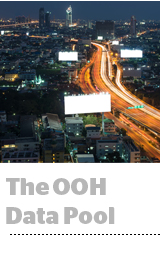 The out-of-home market is turning its real-world infrastructure into a tool for data-driven digital media.
The out-of-home market is turning its real-world infrastructure into a tool for data-driven digital media.
An OOH campaign nowadays for a CPG client may look more like a tapestry of strategic relationships.
The media provider may allow some mobile tracking (in the US that probably means Outfront or Clear Channel, which together account for a large majority of all OOH ad revenue), and that data is then connected to the Wi-Fi or beacon system of partner retailers and location data providers (like Foursquare, Yelp or PlaceIQ). That data can then be used to confirm whether a mobile ad or billboard drove people to a store.
In key media markets like New York, Los Angeles and Chicago, OOH media providers have begun monetizing their legacy billboard infrastructures like physical real estate for digital tracking, enabling mobile providers, marketing agencies, tech vendors and others to place hardware to connect with mobile devices.
“Next time you pass a billboard in a major city, stop and look and you may very well see a row of bunny ear antennas,” said Andy Sriubas, Outfront EVP of strategy and planning.
Letting data-hungry marketers piggyback on its real estate is “a nice, growing revenue stream,” said Sriubas, though he wouldn’t break out details.
OOH sits at “the convergence of mobile and local communications,” said Matthieu Habra, CEO of the Havas OOH shop Adcity, which launched Tuesday. Adcity is an OOH media-buying agency, but it also plans to rely on a steady stream of business from other Havas agencies that want to use it as a spot solution for proximity-based engagement and measurement.
“OOH isn’t just traditional billboards and screens, it’s mobile,” Habra said.
Consequently, OOH buys are becoming more services-based. This is necessary as more third parties make their data or audiences available for OOH buys. Over the past year, Yelp and Foursquare have turned themselves into enterprise data providers, telcos have talked about monetizing their subscriber location data and retailers and tech companies have scaled their beacon networks.
Kenneth Brinkmann, senior VP of digital at the Dentsu Aegis OOH specialist agency Posterscope, has seen the transition firsthand.
“We’re a legacy agency built on media buying and planning, but what we do with it now is more of a consultancy-based approach,” he said.
Yet most of the traction is happening in Europe, where these new features can be better managed. Brinkmann noted the use of location data for OOH measurement approach is in-market in Europe and still requires adoption in the US.
The US might be more lucrative, but “it’s just so damn huge,” said Brinkmann. Adcity also is focused on building European business before entering the US market later this year.













